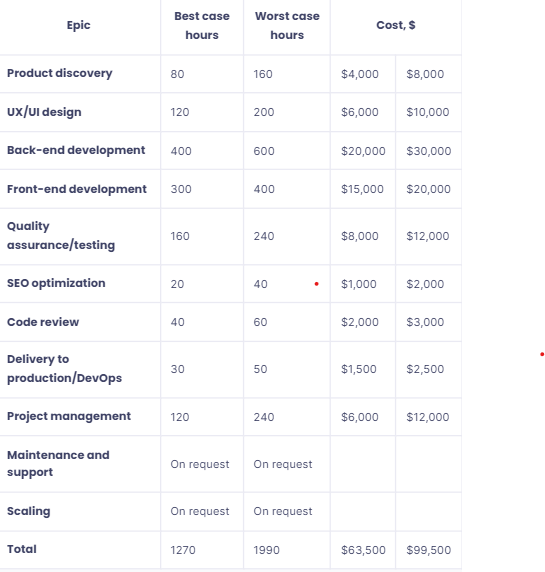In the world of startups, the term "Minimum Viable Product" or MVP, holds a pivotal role. At its core, an MVP is the most stripped-down version of a product that can still be released to the market. The primary goal? To test business hypotheses with minimal resources and gather invaluable feedback from early adopters.
This approach is not just about bringing a product to life quickly; it’s about smartly gauging consumer interest and refining the product based on real user data. In essence, an MVP allows entrepreneurs to learn what their customers truly want, avoiding the costly and common pitfall of building features that no one really needs.
By focusing on the essential functionalities that meet core user needs, an MVP serves as a powerful tool to iterate and evolve a startup's vision into a successful product.
The Purpose and Advantages of an MVP
Core Concept and Utility
In the bustling world of startups, the concept of a Minimum Viable Product (MVP) isn’t just a strategy—it's a crucial lifeline. At its core, an MVP is about building the most basic version of your product that is still able to function and satisfy early adopters.
The real magic of an MVP lies in its ability to test the waters without diving headfirst into costly development. It’s about answering a critical question: "Does my idea have legs?" By introducing an MVP, startups can gather insights, gauge customer interest, and iterate before making significant investments.
This approach not only conserves resources but also aligns product development with real user feedback, ensuring that the final product is not just viable but valuable to its users.
Benefits of MVP Development
The advantages of developing an MVP extend far beyond simple cost savings, touching every aspect of a startup's trajectory. Firstly, market validation comes into play. An MVP allows you to verify if there’s a market for your product without the full-scale rollout. This is essential in avoiding the pitfall of developing products that, while innovative, may not meet an existing market need.
Secondly, developing an MVP is inherently cost-efficient. Since you’re only constructing the bare minimum to test your hypothesis, you're not overcommitting funds to unproven ideas. This lean approach frees up resources to focus on areas of the product that are proven to resonate with your audience.
Risk mitigation is another critical benefit. By its nature, an MVP requires minimal resources to get off the ground, which means if the concept doesn’t hit the mark, you haven’t exhausted your budget. This allows you to fail fast, learn, and pivot without catastrophic financial implications.
Finally, when it comes to securing funding, an MVP can be a golden ticket. Investors are more inclined to support a project that has demonstrated real-world application and user interest. An MVP provides tangible evidence that there’s a demand for your product, thereby increasing your chances of securing the capital needed for further development.
Factors Influencing the Cost of MVP Development
When you're gearing up to build an MVP, the cost can feel like a puzzle with various pieces affecting the final picture. Let’s break down these components to see how they weave together to form the financial blueprint of your MVP.
Product Complexity: Simplicity is economical; complexity costs. The more intricate your product features, the higher the price tag. This is because complex features require more time to design, develop, and test, which means more hours for which your development team needs compensation. It’s like cooking a gourmet meal instead of a simple sandwich—it requires more ingredients and more refined skills.
Design and User Experience (UI/UX): Never underestimate the power of design. A well-thought-out design that enhances user experience can make your MVP more appealing and user-friendly, encouraging early adoption.
However, achieving this level of design sophistication involves detailed wireframing, prototyping, and user testing, all of which add to the costs. Investing in UI/UX is like investing in a high-quality foundation for a house—it’s crucial for longevity and usability.
Technology Choices: The backbone of your MVP is the technology it's built on. Different tech stacks have different costs associated with them. Some technologies are open-source and free, while others might involve licensing fees.
Additionally, the rarity or ubiquity of the skills required to use the technology also affects cost. If you choose a stack that’s in high demand but low supply, you’ll pay more for skilled developers.
Development Team: The structure and location of your development team play a significant role in determining costs. An in-house team might seem expensive upfront due to salaries and benefits, but it offers better control and coordination. Outsourcing, on the other hand, can be cost-effective, especially if you tap into markets where the labor cost is lower.
However, managing remote teams can introduce challenges that might increase costs indirectly through delays or communication lapses.
Development Timeline: Time is money, as they say, and this is particularly true in software development. A rushed project often requires more resources to meet tight deadlines, which can inflate costs. Conversely, a well-planned timeline allows for a more economical use of resources, with time to iterate based on feedback, potentially saving money in the long run by avoiding costly late-stage changes.
Understanding these factors will not only help you budget more effectively but also strategically plan your MVP’s development to align with your business goals and financial capabilities. Like a captain navigating through waters, knowing these elements helps steer your project toward success without unnecessary expenditures.
Planning and Budgeting for MVP Development
When venturing into the development of a Minimum Viable Product (MVP), a meticulously planned budget isn’t just advisable; it’s crucial. Your budget influences every decision, from the scope of your MVP to the technologies you choose and the team you build. Managing this budget effectively ensures you can validate your product idea without overspending, keeping your startup agile and responsive.
Key Strategies for Budget Management
The art of budget management for an MVP starts with prioritization. Begin by identifying the core features that are absolutely essential to your product—these are your must-haves. Everything else falls into the nice-to-have category and should only be considered once the essentials are funded.
This focused approach not only conserves resources but also streamlines the development process, ensuring that your team isn’t distracted by features that don’t serve the primary goal of your MVP.
Another effective strategy is adopting an iterative development approach. This method allows you to develop your MVP in stages, reviewing and adjusting your spending as you progress. Each stage provides a checkpoint where you can assess the product and decide if further investment is warranted.
This phased approach reduces the risk of large-scale financial commitment upfront and provides flexibility to adapt to feedback and changing market conditions.
Cost Reduction Techniques
To further stretch your budget, consider outsourcing or offshoring some or all of the development work. This can significantly reduce costs without compromising on quality.
Countries like India, Ukraine, and the Philippines have a wealth of tech talent at rates much lower than those in Western markets. Outsourcing can also give you access to a larger pool of expertise, allowing you to find the perfect fit for your project needs at a fraction of the cost.
Leveraging modern technology choices can also lead to cost savings. Embrace open-source technologies and low-code or no-code platforms where appropriate. These tools can drastically reduce the amount of custom coding required, allowing for faster development at a lower cost.
Additionally, they often come with supportive communities and abundant resources, which can help resolve issues more quickly and keep your project moving forward.
By thoughtfully managing your budget and strategically reducing costs, you can create an MVP that effectively tests your business concept without draining your resources.
This balanced approach sets the stage for a product that can evolve based on real user feedback, ultimately increasing your chances of success in the competitive startup landscape.
Detailed Development Stages and Their Costs

Building an MVP is akin to preparing for a major expedition. It requires meticulous planning, adept execution, and continuous adjustment—all while keeping a keen eye on budget constraints. Here’s how the journey typically unfolds, complete with cost implications for each stage:
1. Concept and Planning: Initial Planning Costs
The outset of your MVP adventure is all about laying down a solid foundation. This stage involves deep dives into market research, strategic planning, and aligning your product vision with user needs. For an MVP, budgeting anywhere from $4,000 to $8,000 is typical, covering the essentials of stakeholder meetings and initial feature prioritization. This initial investment in planning can dramatically reduce the risk of costly pivots and redesigns later on.
2. Design and Prototyping: Costs Involved in Design and Prototype Development
As you move into design and prototyping, this is where your abstract idea starts taking a concrete shape. Expect to allocate $6,000 to $10,000 for this critical phase. Costs here cover everything from UX/UI design, creating interactive wireframes, to user testing.
The goal is to sculpt a prototype that not only resonates visually but is also intuitive for end-users. Investing in robust design processes here ensures that your MVP is not just usable but delightful, setting the stage for better user adoption.
3. Development and Implementation: Breakdown of Development Costs
Transitioning to development, where your designs are transformed into a functional MVP, costs can vary widely based on the complexity of your MVP. For simpler apps, you might spend as little as $24,000, but more sophisticated projects could require up to $96,000.
This stage absorbs the bulk of your budget, reflecting the technical complexity and the resources required to code, integrate, and bring the MVP to life. Agile development practices are often employed here to allow for flexibility and iterative improvements, which, while potentially adding to the cost, enable a more refined final product.
4. Testing and Iteration: Financial Implications of Testing and Feedback Incorporation
No MVP is ready for launch without rigorous testing and iterations based on user feedback. Budgeting for this final leg should consider both the direct costs of testing and the potential costs associated with refining the MVP.
Typical expenses could range from $4,800 to $19,200, depending on the depth of testing and the extent of the iterations required. This phase is crucial for polishing the product, ensuring stability, and enhancing user engagement—a critical investment for long-term success.
Post-Launch Expenses and Maintenance
After the initial excitement of launching your MVP wears off, the real work begins to ensure it thrives in a competitive market. Continual support and updates are not just add-ons; they're essential to keeping your MVP relevant and functional.
Expect to allocate around 20% of your initial development budget annually towards regular maintenance—this covers everything from bug fixes to minor enhancements.
Scaling your MVP as your user base grows can significantly increase costs, but it’s a necessary investment if your initial launch shows promising user engagement. Marketing, too, plays a pivotal role in the post-launch phase.
Whether it's through social media campaigns, content marketing, or paid ads, getting the word out about your MVP will require a strategic and often substantial budget. These ongoing efforts ensure that your MVP doesn’t just launch successfully but continues to grow and adapt in its market.
Successful MVP Examples
Consider Dropbox and Amazon as prime examples of MVP success stories. Dropbox started with a simple yet effective demo video that showcased the technology's potential, leading to significant user sign-up even before the actual product was fully built.
Amazon began as an online bookstore, testing the broader market viability for e-commerce before expanding into the behemoth it is today. Both companies exemplified the power of starting small, proving their concepts, and meticulously scaling up based on user data and feedback.
Conclusion
Understanding the costs involved in developing an MVP is crucial for startups looking to innovate while managing resources wisely. This insight helps in prioritizing essential features, streamlining budgets, and ultimately steering your product from a basic prototype to a market-ready solution effectively and efficiently.





